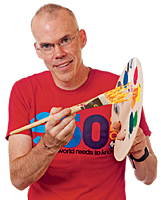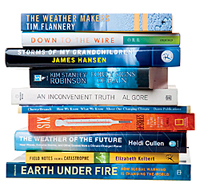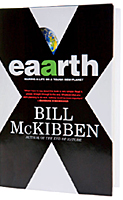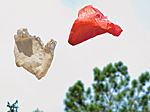sierraclub.org - sierra magazine - september/october 2010 - mixed media
The Art of Climate Change
Global warming sparks operas, light shows, Books, and Blogs
 Caleb Kenna
Caleb Kenna
Five years ago, I wrote an article for
Grist lamenting how few artworks had been made about climate change, considering that it was the biggest problem we'd ever faced. "It hasn't registered in our gut; it isn't part of our culture," I wrote. "Where are the books? The poems? The plays? The goddamn operas?"
That was the last moment I could have made such a critique. Not only did every amateur poet in America e-mail me his or her climate-change verse, but also, within a year, Al Gore had given us An Inconvenient Truth, which ensured that global warming would never disappear from the radar screen.
Since then, there have been at least a dozen other documentaries, from Leonardo DiCaprio's The 11th Hour (Warner Independent Pictures, 2007) to ludicrous rebuttals like The Great Global Warming Swindle (Wag TV, 2007). We've had operas—check out And While London Burns, "a requiem for a warming world." And we've had Brian Eno light up the outside of the Sydney Opera House with an installation designed to raise awareness of climate change. As Eno put it, "artists can create a sense of what is cool and what is not, what is acceptable, exciting, timely. I would like to see a future where artists think that they have a right to contemplate things like global warming."
 Lori Eanes
Lori Eanes
Still, most of the work on climate change has come from scientists and politicos. And since what we first called the greenhouse effect emerged as a crisis at the same time as the Internet, it's no wonder that cyberspace is home to much of the debate. Here are the crucial sites:
Climate Progress is where you'll find out about the latest science and how it's playing in D.C. The Daily Climate aggregates essentially everything written about global warming in the English-language press and offers excellent original reporting too. Journalist Andrew C. Revkin's New York Times blog, Dot Earth, has diversified beyond climate change, but it remains vigilant about the issue.
Scientists gravitate to RealClimate (realclimate.org), which has detailed discussions of the key features of climate science (so it's not the best destination if you're just starting out).
When you need arguments for Thanksgiving dinner about why your uncle's Rush Limbaugh talking points are wrong, go to DeSmogBlog. For more family-reunion fodder, see Grist's invaluable How to Talk to a Climate Skeptic and the incredibly arch Friends of Gin and Tonic.
Activists, especially younger ones, hang out at the breezy It's Getting Hot in Here as well as Treehugger. And when they want to know what their opponents are up to, they check out Marc Morano's Climate Depot, a kind of Drudge Report for climate news in a bizarre alternate world where hot is cold.
I wrote one of the first books about climate change for a general audience, The End of Nature (Random House, 1989), and since then there's been an avalanche. James Hansen, the planet's most important climatologist, recently authored the compelling Storms of My Grandchildren: The Truth About the Coming Climate Catastrophe and Our Last Chance to Save Humanity (Bloomsbury USA, 2009); Oberlin visionary David Orr presents a guarded best-case scenario in Down to the Wire: Confronting Climate Collapse (Oxford University Press, 2009); and New Yorker staff writer Elizabeth Kolbert, who put the issue of ocean acidification on the map, distills her own introduction to climate issues in the austere and powerful Field Notes from a Catastrophe: Man, Nature, and Climate Change (Bloomsbury USA, 2006).
Heidi Cullen was once the voice of climate sanity on cable TV, enduring endless scorn from denialists, who pressured the Weather Channel to can her. The climatologist brings her calm but persuasive voice to The Weather of the Future: Heat Waves, Extreme Storms, and Other Scenes from a Climate-Changed Planet (HarperCollins, 2010).
Ross Gelbspan exposed the fossil fuel industry's conspiracy to deceive the public in The Heat Is On: The Climate Crisis, the Cover-up, the Prescription (Basic Books, 1998). Australian scientist Tim Flannery has convinced many skeptics with The Weather Makers: How Man Is Changing the Climate and What It Means for Life on Earth (Atlantic Monthly Press, 2006), while Mark Lynas neatly divides our options into six increments in Six Degrees: Our Future on a Hotter Planet (National Geographic, 2008). And Mark Bowen delivers a high-adventure glacial detective story in Thin Ice: Unlocking the Secrets of Climate in the World's Highest Mountains (Henry Holt, 2005).
Rather look at pictures? Gary Braasch is your guy. The images in his Earth Under Fire: How Global Warming Is Changing the World (UC Press, 2007) come from every corner of a damaged planet. Prefer novels? Pick up Forty Signs of Rain (Spectra, 2004), from veteran science fiction writer Kim Stanley Robinson.
It's always hard to know how early to introduce children to a subject as big and scary as climate change. For kids ages 9 to 12, Revkin's The North Pole Was Here: Puzzles and Perils at the Top of the World (Kingfisher, 2007) isn't too alarming, and photographer Braasch and Lynne Cherry's How We Know What We Know About Our Changing Climate: Scientists and Kids Explore Global Warming (Dawn Publications, 2008) is straightforward and useful. Cherry also coordinated the ambitious film project Young Voices on Global Warming, chunks of which are available at youngvoicesonclimatechange.com. Teens will like the surprisingly comprehensive Rough Guide to Climate Change (Rough Guides, 2006) by Robert Henson.
The danger, of course, is that all this will make you despair. Which is why I hope you'll check out 350.org, a site I cofounded. It provides the most encouraging item on this entire list: about 25,000 pictures from rallies mounted in 181 countries (flickr.com/photos/350org/sets). You can join the fray on October 10, when 350.org hosts a Global Work Party. —Bill McKibben
From Bill McKibben's Eaarth: Making a Life on a Tough New Planet (Times Books, 2010):
 Lori Eanes
Lori Eanes
Castaway
 Courtesy of ITVS
Courtesy of ITVS
Not since
American Beauty has a plastic bag played such a pivotal role in a film. This time, the polymer protagonist struggles with its own immortality, with narration by Werner Herzog, director of such noted documentaries as
Encounters at the End of the World (2007) and
Grizzly Man (2005).
Plastic Bag is part of the Futurestates project, an online series of 11 short films that tackle global issues and their implications. To watch, go to
futurestates.tv.
—Reed McManus